Abstract
1. Protein–polysaccharides of chondroitin 4-sulphate were extracted with neutral calcium chloride from pig laryngeal cartilage that was not completely homogenized. The protein–polysaccharides were purified by precipitation with 9-aminoacridine. On zone electrophoresis in compressed glass fibre at pH7·2 it was separated into two fractions, although two distinct zones were not obtained. These fractions, which had already been shown to differ in their antigenic determinants, also differed considerably in amino acid composition, total protein, hexose and glucosamine contents. 2. The fraction of higher mobility contained approx. 2% of protein and only traces of glucosamine. Serine and glycine accounted for over half the total amino acid residues, but aromatic, basic and sulphur-containing amino acids were not detected. The weight-average molecular weight, determined by sedimentation, was 230000. 3. Assuming that there was the same sequence of neutral sugars at the linkage points as in PP-L fraction (protein–polysaccharide light fraction), the approximate molar ratio of hexose to serine suggested that most of the serine residues were linked to chondroitin sulphate chains. Support for this was derived from the agreement between the weight-average molecular weight of the chondroitin sulphate–peptide after proteolysis, and the chain weight calculated from its serine content. The chain weight based on the serine content of the fraction of higher electrophoretic mobility was approximately similar. 4. In contrast, the fraction of lower electrophoretic mobility resembled PP-L fraction in its amino acid composition, protein and glucosamine contents. The presence of glucosamine, together with the higher hexose content, suggested that this fraction contained some keratan sulphate. 5. The relatively low molecular weight of the fraction of higher mobility enabled it to be extracted without complete disintegration of the cartilage. The unlikelihood of its being produced by autolytic enzymes is discussed.
Full text
PDF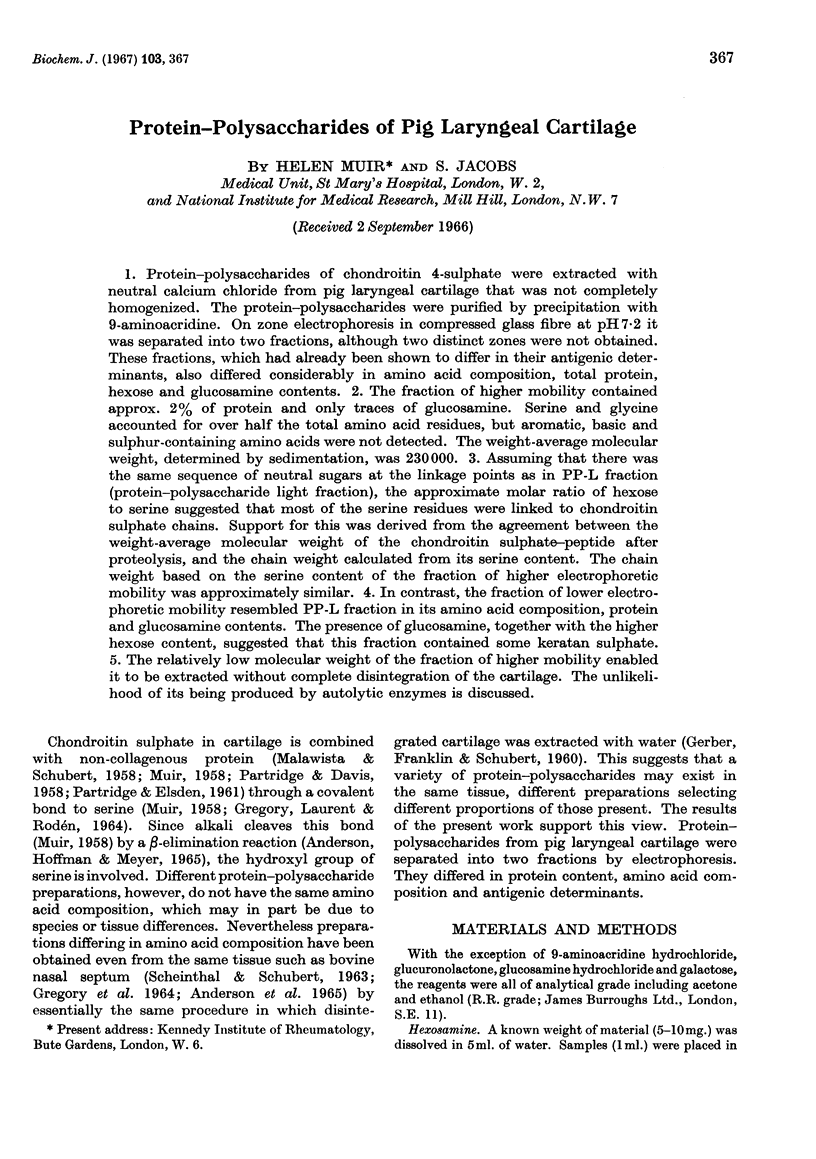
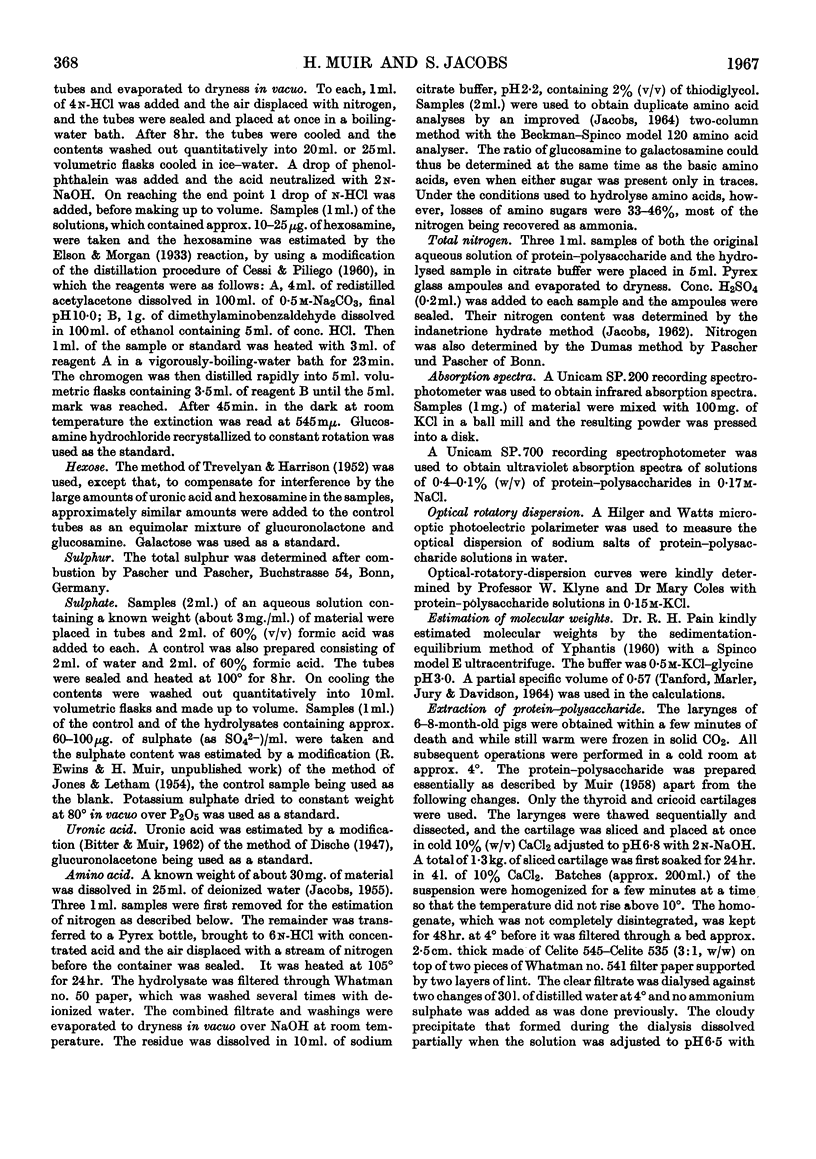
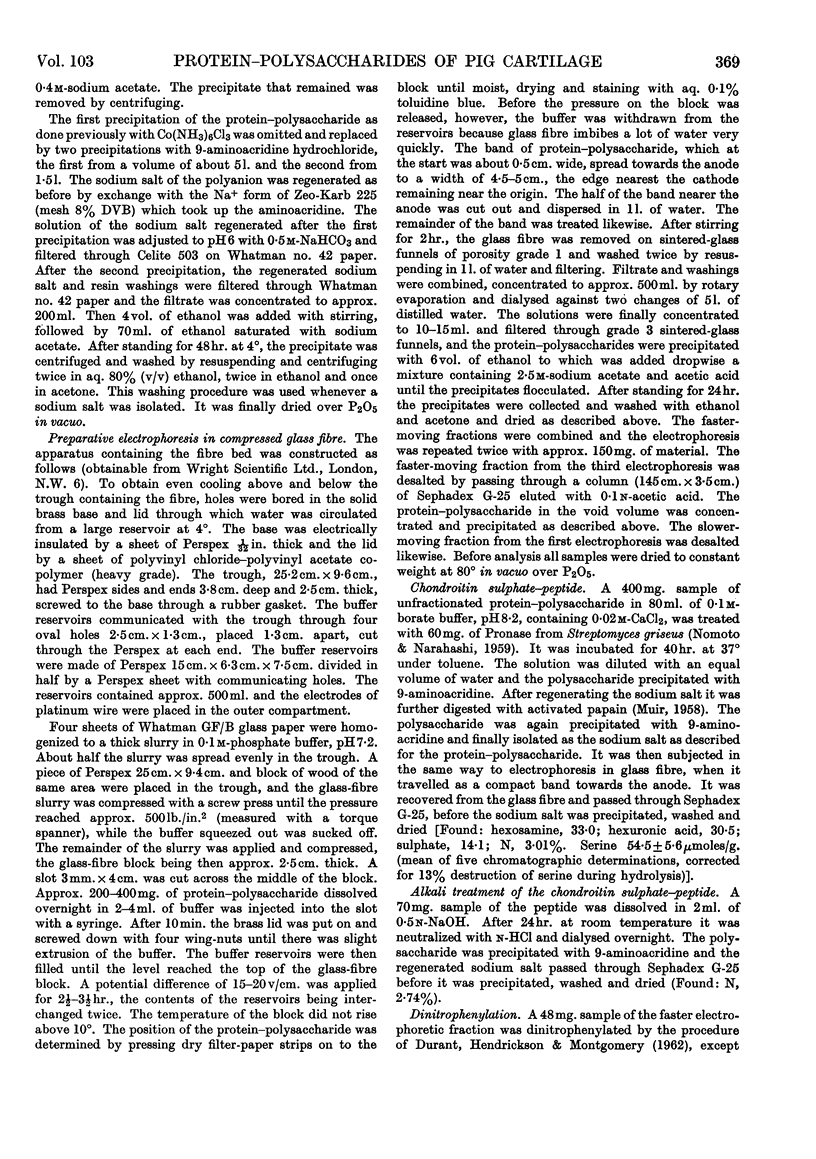
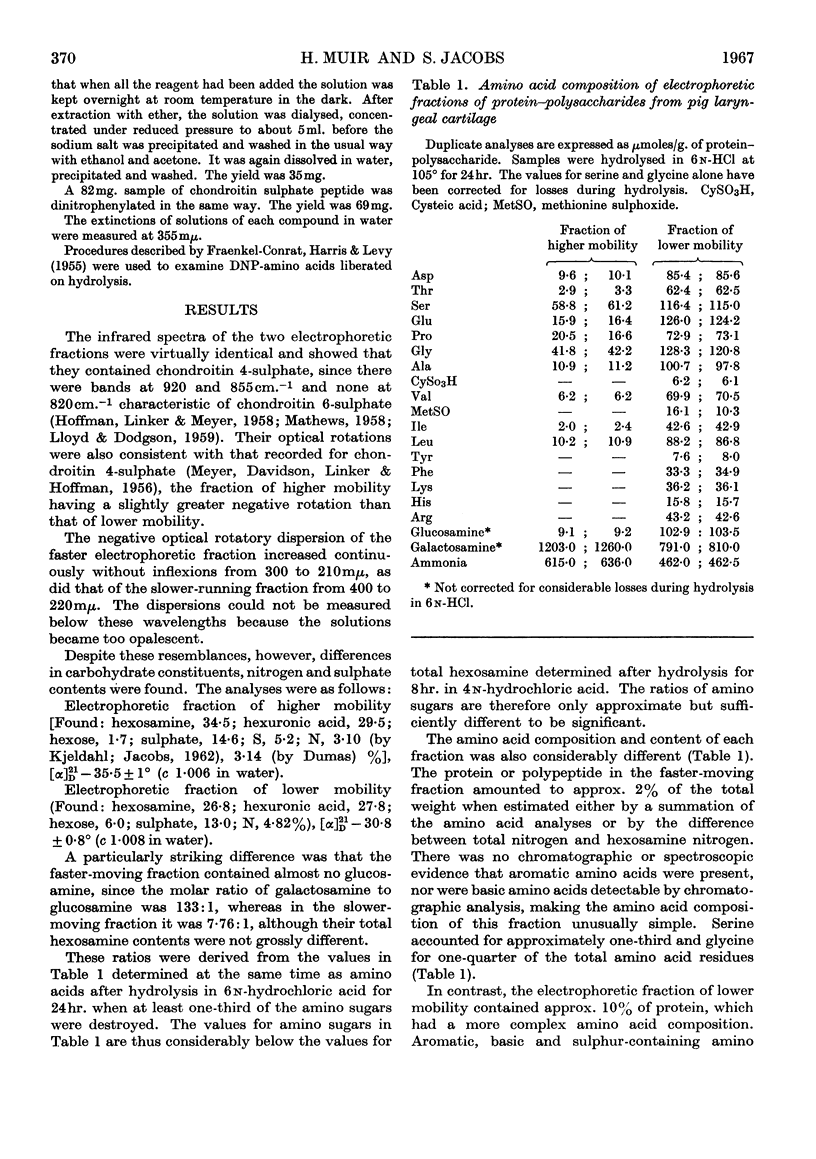
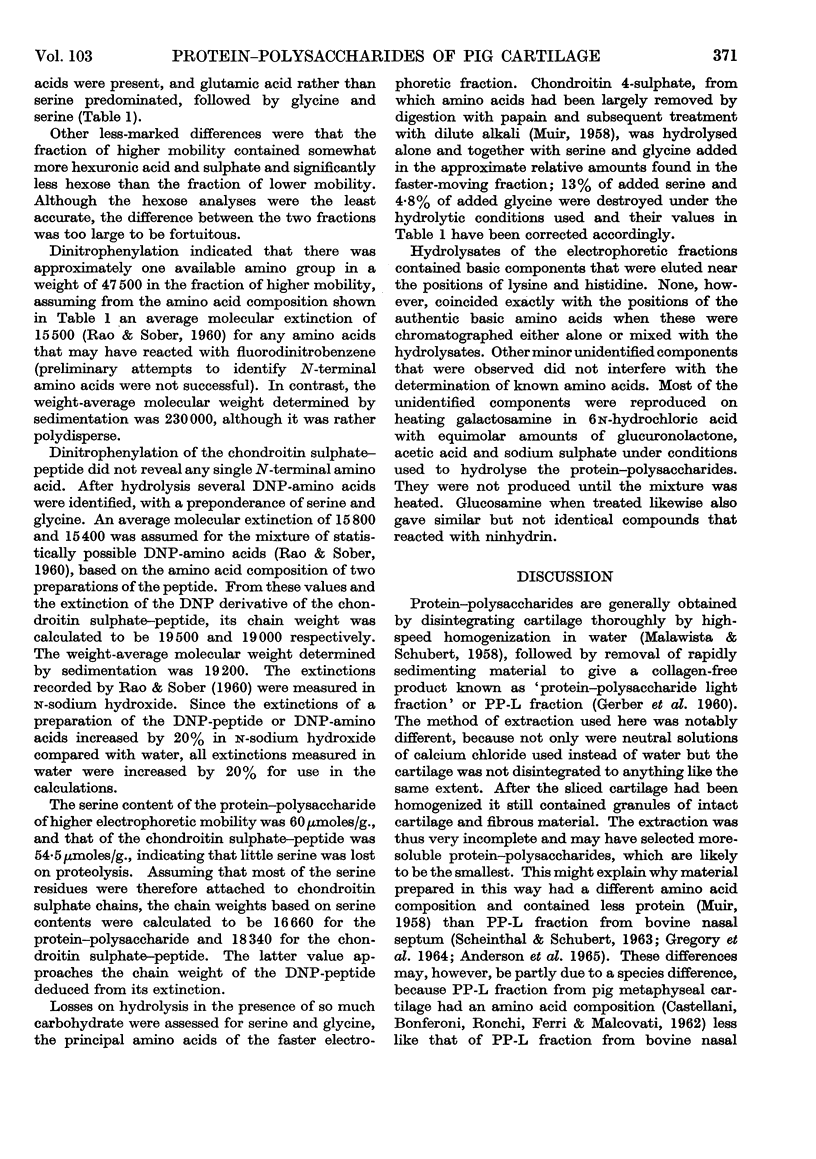
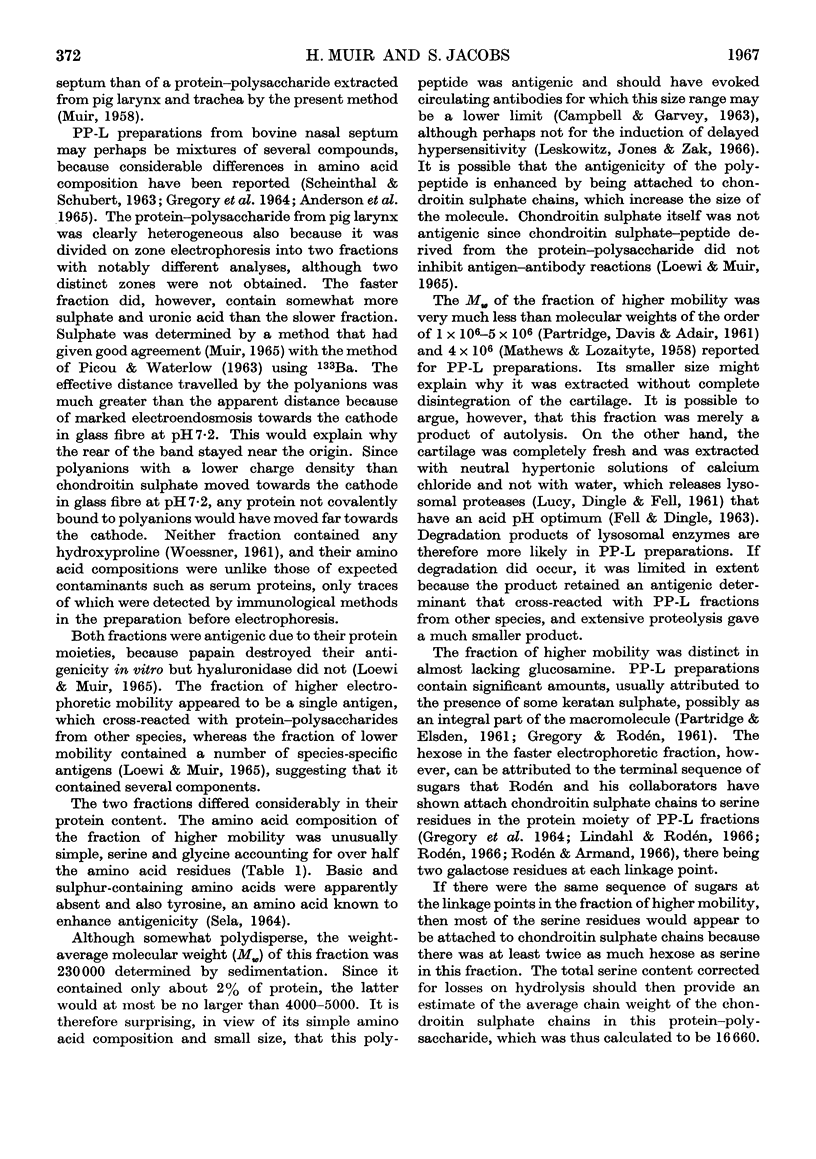

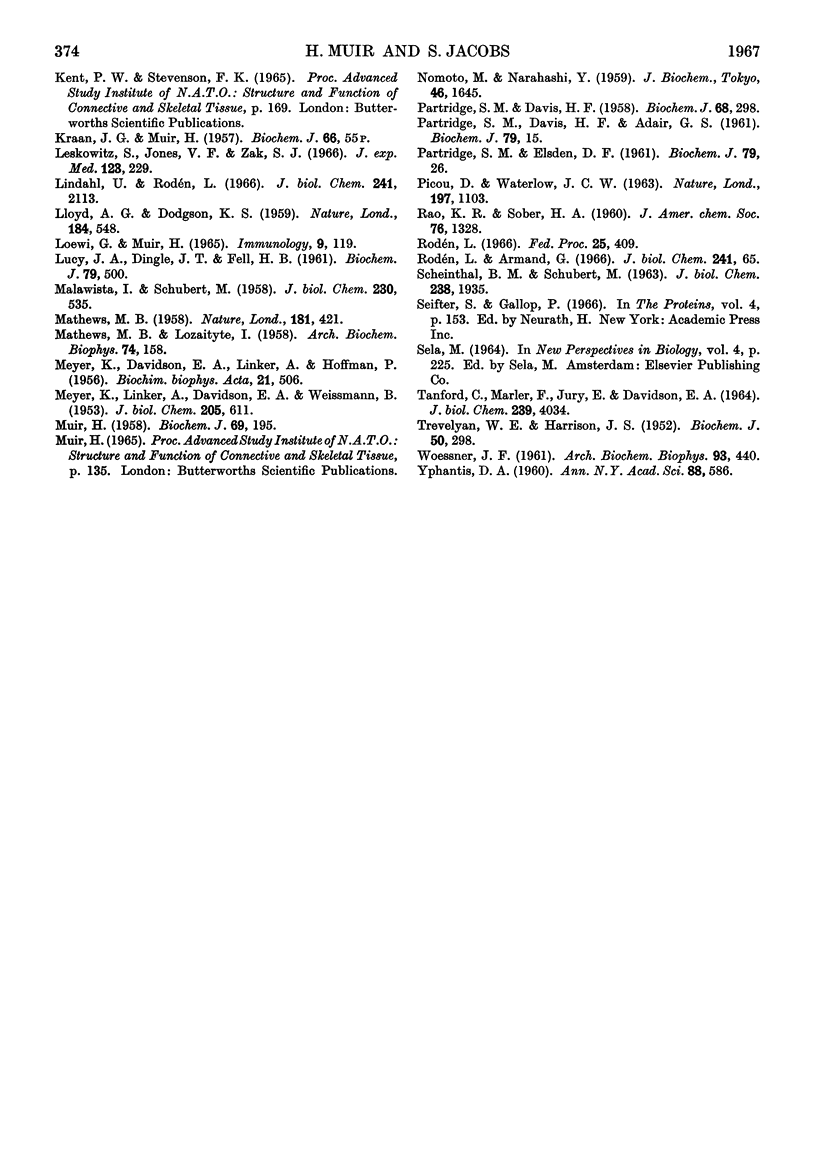
Selected References
These references are in PubMed. This may not be the complete list of references from this article.
- ANDERSON B., HOFFMAN P., MEYER K. THE O-SERINE LINKAGE IN PEPTIDES OF CHONDROITIN 4- OR 6-SULFATE. J Biol Chem. 1965 Jan;240:156–167. [PubMed] [Google Scholar]
- BITTER T., MUIR H. M. A modified uronic acid carbazole reaction. Anal Biochem. 1962 Oct;4:330–334. doi: 10.1016/0003-2697(62)90095-7. [DOI] [PubMed] [Google Scholar]
- CESSI C., PILIEGO F. The determination of amino sugars in the presence of amino acids and glucose. Biochem J. 1960 Dec;77:508–510. doi: 10.1042/bj0770508. [DOI] [PMC free article] [PubMed] [Google Scholar]
- DAVIDSON E., HOFFMAN P., LINKER A., MEYER K. The acid mucopolysaccharides of connective tissue. Biochim Biophys Acta. 1956 Sep;21(3):506–518. doi: 10.1016/0006-3002(56)90188-3. [DOI] [PubMed] [Google Scholar]
- DINGLE J. T., LUCY J. A., FELL H. B. Studies on the mode of action of excess of vitamin A. 1. Effect of excess of vitamin A on the metabolism and composition of embryonic chick-limb cartilage grown in organ culture. Biochem J. 1961 Jun;79:497–500. doi: 10.1042/bj0790497. [DOI] [PMC free article] [PubMed] [Google Scholar]
- Elson L. A., Morgan W. T. A colorimetric method for the determination of glucosamine and chondrosamine. Biochem J. 1933;27(6):1824–1828. doi: 10.1042/bj0271824. [DOI] [PMC free article] [PubMed] [Google Scholar]
- FELL H. B., DINGLE J. T. Studies on the mode of action of excess of vitamin A. 6. Lysosomal protease and the degradation of cartilage matrix. Biochem J. 1963 May;87:403–408. doi: 10.1042/bj0870403. [DOI] [PMC free article] [PubMed] [Google Scholar]
- FRAENKEL-CONRAT H., HARRIS J. I., LEVY A. L. Recent developments in techniques for terminal and sequence studies in peptides and proteins. Methods Biochem Anal. 1955;2:359–425. doi: 10.1002/9780470110188.ch12. [DOI] [PubMed] [Google Scholar]
- GERBER B. R., FRANKLIN E. C., SCHUBERT M. Ultracentrifugal fractionation of bovine nasal chondromucoprotein. J Biol Chem. 1960 Oct;235:2870–2875. [PubMed] [Google Scholar]
- GREGORY J. D., LAURENT T. C., RODEN L. ENZYMATIC DEGRADATION OF CHONDROMUCOPROTEIN. J Biol Chem. 1964 Oct;239:3312–3320. [PubMed] [Google Scholar]
- HIRS C. H., STEIN W. H., MOORE S. The amino acid composition of ribonuclease. J Biol Chem. 1954 Dec;211(2):941–950. [PubMed] [Google Scholar]
- HOFFMAN P., LINKER A., MEYER K. The acid mucopolysaccharides of connective tissue. III. the sulfate linkage. Biochim Biophys Acta. 1958 Oct;30(1):184–185. doi: 10.1016/0006-3002(58)90256-7. [DOI] [PubMed] [Google Scholar]
- Jirgensons B. Optical rotatory dispersion of nonhelical proteins. J Biol Chem. 1966 Jan 10;241(1):147–152. [PubMed] [Google Scholar]
- LLOYD A. G., DODGSON K. S. Infra-red spectra of carbohydrate sulphate esters. Nature. 1959 Aug 15;184(Suppl 8):548–549. doi: 10.1038/184548a0. [DOI] [PubMed] [Google Scholar]
- Leskowitz S., Jones V. E., Zak S. J. Immunochemical study of antigenic specificity in delayed hypersensitivity. V. Immunization with monovalent low molecular weight conjugates. J Exp Med. 1966 Feb 1;123(2):229–237. doi: 10.1084/jem.123.2.229. [DOI] [PMC free article] [PubMed] [Google Scholar]
- Lindahl U., Rodén L. The chondroitin 4-sulfate-protein linkage. J Biol Chem. 1966 May 10;241(9):2113–2119. [PubMed] [Google Scholar]
- Loewi G., Muir H. The antigenicity of chondromucoprotein. Immunology. 1965 Aug;9(2):119–127. [PMC free article] [PubMed] [Google Scholar]
- MALAWISTA I., SCHUBERT M. Chondromucoprotein: new extraction method and alkaline degradation. J Biol Chem. 1958 Jan;230(1):535–544. [PubMed] [Google Scholar]
- MATHEWS M. B. Isomeric chondroitin sulphates. Nature. 1958 Feb 8;181(4606):421–422. doi: 10.1038/181421a0. [DOI] [PubMed] [Google Scholar]
- MATHEWS M. B., LOZAITYTE I. Sodium chondroitin sulfate-protein complexes of cartilage. I. Molecular weight and shape. Arch Biochem Biophys. 1958 Mar;74(1):158–174. doi: 10.1016/0003-9861(58)90210-8. [DOI] [PubMed] [Google Scholar]
- MEYER K., LINKER A., DAVIDSON E. A., WEISSMANN B. The mucopolysaccharides of bovine cornea. J Biol Chem. 1953 Dec;205(2):611–616. [PubMed] [Google Scholar]
- MUIR H. The nature of the link between protein and carbohydrate of a chondroitin sulphate complex from hyaline cartilage. Biochem J. 1958 Jun;69(2):195–204. doi: 10.1042/bj0690195. [DOI] [PMC free article] [PubMed] [Google Scholar]
- PARTRIDGE S. M., DAVIS H. F., ADAIR G. S. The chemistry of connective tissues. 6. The constitution of the chondroitin sulphate-protein complex in cartilage. Biochem J. 1961 Apr;79:15–26. doi: 10.1042/bj0790015. [DOI] [PMC free article] [PubMed] [Google Scholar]
- PARTRIDGE S. M., DAVIS H. F. The chemistry of connective tissues. 4. The presence of a non-collagenous protein in cartilage. Biochem J. 1958 Feb;68(2):298–305. doi: 10.1042/bj0680298. [DOI] [PMC free article] [PubMed] [Google Scholar]
- Partridge S. M., Elsden D. F. The chemistry of connective tissues. 7. Dissociation of the chondroitin sulphate-protein complex of cartilage with alkali. Biochem J. 1961 Apr;79(1):26–32. doi: 10.1042/bj0790026. [DOI] [PMC free article] [PubMed] [Google Scholar]
- Rodén L., Armand G. Structure of the chondroitin 4-sulfate-protein linkage region. Isolation and characterization of the disaccharide 3-O-beta-D-glucuronosyl-D-galactose. J Biol Chem. 1966 Jan 10;241(1):65–70. [PubMed] [Google Scholar]
- SCHEINTHAL B. M., SCHUBERT M. Fractionation of the degradation products of compounds of protein and polysaccharide from cartilage. J Biol Chem. 1963 Jun;238:1935–1940. [PubMed] [Google Scholar]
- TANFORD C., MARLER E., JURY E., DAVIDSON E. A. DETERMINATION OF THE MOLECULAR WEIGHT DISTRIBUTION OF CHONDROITIN SULFATE B BY SEDIMENTATION EQUILIBRIUM. J Biol Chem. 1964 Dec;239:4034–4040. [PubMed] [Google Scholar]
- TREVELYAN W. E., HARRISON J. S. Studies on yeast metabolism. I. Fractionation and microdetermination of cell carbohydrates. Biochem J. 1952 Jan;50(3):298–303. doi: 10.1042/bj0500298. [DOI] [PMC free article] [PubMed] [Google Scholar]
- WOESSNER J. F., Jr The determination of hydroxyproline in tissue and protein samples containing small proportions of this imino acid. Arch Biochem Biophys. 1961 May;93:440–447. doi: 10.1016/0003-9861(61)90291-0. [DOI] [PubMed] [Google Scholar]
- YPHANSTIS D. A. Rapid determination of molecular weights of peptides and preteins. Ann N Y Acad Sci. 1960 Aug 31;88:586–601. doi: 10.1111/j.1749-6632.1960.tb20055.x. [DOI] [PubMed] [Google Scholar]


